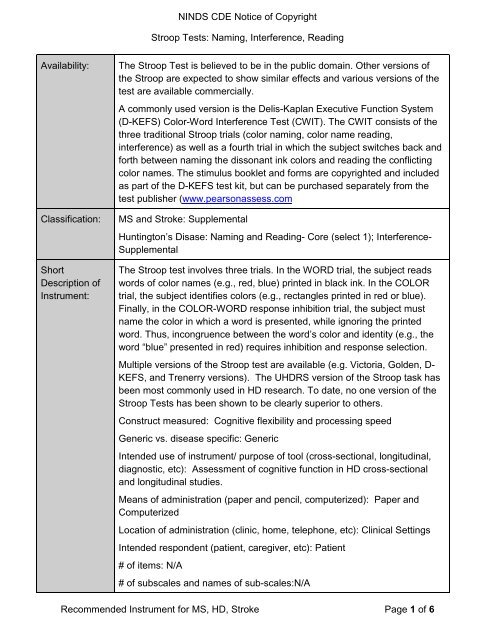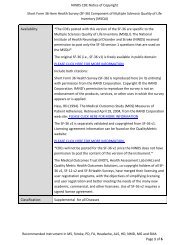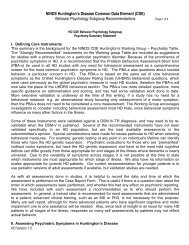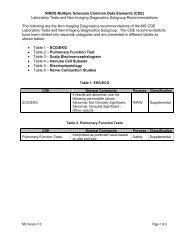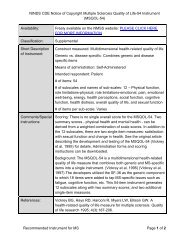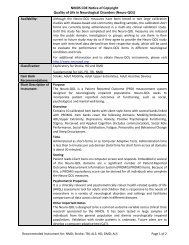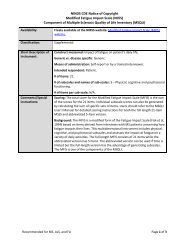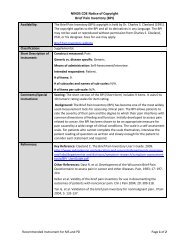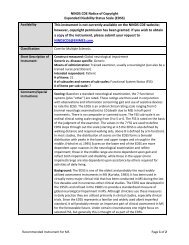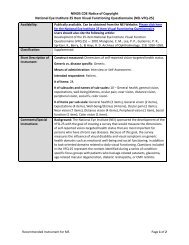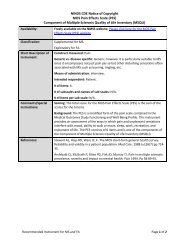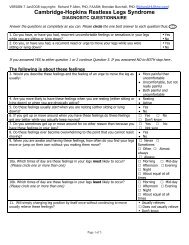NOC - NINDS Common Data Elements
NOC - NINDS Common Data Elements
NOC - NINDS Common Data Elements
Create successful ePaper yourself
Turn your PDF publications into a flip-book with our unique Google optimized e-Paper software.
<strong>NINDS</strong> CDE Notice of Copyright<br />
Stroop Tests: Naming, Interference, Reading<br />
Availability:<br />
Classification:<br />
Short<br />
Description of<br />
Instrument:<br />
The Stroop Test is believed to be in the public domain. Other versions of<br />
the Stroop are expected to show similar effects and various versions of the<br />
test are available commercially.<br />
A commonly used version is the Delis-Kaplan Executive Function System<br />
(D-KEFS) Color-Word Interference Test (CWIT). The CWIT consists of the<br />
three traditional Stroop trials (color naming, color name reading,<br />
interference) as well as a fourth trial in which the subject switches back and<br />
forth between naming the dissonant ink colors and reading the conflicting<br />
color names. The stimulus booklet and forms are copyrighted and included<br />
as part of the D-KEFS test kit, but can be purchased separately from the<br />
test publisher (www.pearsonassess.com<br />
MS and Stroke: Supplemental<br />
Huntington’s Disase: Naming and Reading- Core (select 1); Interference-<br />
Supplemental<br />
The Stroop test involves three trials. In the WORD trial, the subject reads<br />
words of color names (e.g., red, blue) printed in black ink. In the COLOR<br />
trial, the subject identifies colors (e.g., rectangles printed in red or blue).<br />
Finally, in the COLOR-WORD response inhibition trial, the subject must<br />
name the color in which a word is presented, while ignoring the printed<br />
word. Thus, incongruence between the word’s color and identity (e.g., the<br />
word “blue” presented in red) requires inhibition and response selection.<br />
Multiple versions of the Stroop test are available (e.g. Victoria, Golden, D-<br />
KEFS, and Trenerry versions). The UHDRS version of the Stroop task has<br />
been most commonly used in HD research. To date, no one version of the<br />
Stroop Tests has been shown to be clearly superior to others.<br />
Construct measured: Cognitive flexibility and processing speed<br />
Generic vs. disease specific: Generic<br />
Intended use of instrument/ purpose of tool (cross-sectional, longitudinal,<br />
diagnostic, etc): Assessment of cognitive function in HD cross-sectional<br />
and longitudinal studies.<br />
Means of administration (paper and pencil, computerized): Paper and<br />
Computerized<br />
Location of administration (clinic, home, telephone, etc): Clinical Settings<br />
Intended respondent (patient, caregiver, etc): Patient<br />
# of items: N/A<br />
# of subscales and names of sub-scales:N/A<br />
Recommended Instrument for MS, HD, Stroke Page 1 of 6
<strong>NINDS</strong> CDE Notice of Copyright<br />
Stroop Tests: Naming, Interference, Reading<br />
Scoring<br />
Measurements<br />
Psychometric<br />
Properties<br />
Scoring (include reference to detailed scoring instructions, including<br />
calculation of a total score and subscale scores, and any limitations of scale<br />
or scoring posed by item nonresponse): Scoring for each trial type is based<br />
on the number of correct responses in a fixed amount of time, typically<br />
within 45 seconds. Higher scores indicate better cognitive performance.<br />
Standardization of scores to a reference population (z scores, T scores,<br />
etc): Raw scores can be converted to t scores for different ranges of age<br />
and years of education, depending on norms used. Studies reporting raw<br />
scores should control for age and education.<br />
If scores have been standardized to a reference population, indicate frame<br />
of reference for scoring (general population, HD subjects, other disease<br />
groups, etc).General population (5-90 years of age; education levels of 2 to<br />
20 years).<br />
Type of scale used to describe individual items and total/subscale scores<br />
(nominal, ordinal, or [essentially] continuous): Continuous.<br />
If ordinal or continuous, explain if ceiling or floor effects are to be expected<br />
if the measure is used in specific HD Subgroups. No floor effects. Ceiling<br />
effects can be avoided if any subjects who reach the end of the page before<br />
the allotted time has elapsed are redirected to the top row and continue<br />
working until the end of the alotted time period. Individuals with advanced<br />
disease may struggle with the interference trial.<br />
Reliability: High reliability across different versions.<br />
Test-retest or intra-interview (within rater) reliability (as applicable): Testretest<br />
reliabilities covers periods of 1 minute to 10 days. Reliablities for<br />
Word, Color, and Color-Word are respectively .88, .79 and .71 (Jensen,<br />
1965) and .89, .84., and .73 (Golden, 1975).<br />
Inter-interview (between-rater) reliability (as applicable):<br />
Internal consistency: Correlations among the subtests are moderate to high<br />
(.71 to .84) (Chafetz and Mathew, 2004).<br />
Statistical methods used to assess reliability: Intraclass correlations<br />
Reliability data from the CAB study will be available for the Stroop Word<br />
condition of this task by end of 2012 for 100 control, 100 premanifest, and<br />
50 early HD subjects.<br />
Recommended Instrument for MS, HD, Stroke Page 2 of 6
<strong>NINDS</strong> CDE Notice of Copyright<br />
Stroop Tests: Naming, Interference, Reading<br />
Psychometric<br />
Properties<br />
Rationale/<br />
Justification<br />
(include any<br />
information on<br />
language and<br />
countries/<br />
cultures/ ethnic<br />
groups where<br />
tested)<br />
Construct validity: The interference score correlates well with measures of<br />
attention and prepotent response inhibition (May and Hasler, 1998)<br />
Known Relationships to Other Variables (e.g. gender, education, age, etc):<br />
May not be valid in color-blind individuals. The color-word interference<br />
score is vulnerable to aging (Mitrushina et al., 2005). Age and education<br />
should be controlled if reporting raw scores.<br />
Diagnostic Sensitivity and Specificity, if applicable (in general population,<br />
HD population- premanifest/ manifest, other disease groups):<br />
Strengths: The color and word subtest are particularly sensitive in crosssectional<br />
and longitudinal studies of premanifest and early manifest HD.<br />
Task has been tested at sites in the United States, Canada, United<br />
Kingdom, Australia, Germany, and Spain. Task is easy to administer.<br />
Weaknesses:N/A<br />
Special Requirements for administration: A stopwatch is required.<br />
Administration Time: Assessment takes approximately 2 minutes for each<br />
of the three trial types.<br />
Translations available (e.g. Spanish, French, Other languages): Spanish<br />
(Golden Version), Cantonese (Victoria Version). The UHDRS version is<br />
available in a large number of European languages including Czech,<br />
Danish, Dutch, Finnish, French, German, Italian, Norwegian, Polish,<br />
Portuguese, Spanish and Swedish.<br />
Recommended Instrument for MS, HD, Stroke Page 3 of 6
<strong>NINDS</strong> CDE Notice of Copyright<br />
Stroop Tests: Naming, Interference, Reading<br />
References:<br />
Key Reference:<br />
Stroop, J. R. (1935). Studies of interference in serial verbal reactions.<br />
Journal of Experimental Psychology: General, 18, 643-662.<br />
Golden & Greshwater (2002). The Stroop Color and Word Test: A Manual<br />
for Clinical and Experimental Uses. Wood Dale, IL: Stoelting Co.<br />
Other References:<br />
Chafetz, M. D. & Matthews, L. H. (2004). A new interference score for the<br />
Stroop test. Arch.Clin.Neuropsychol., 19, 555-567.<br />
Jensen, A.R. (1965). Scoring the Stroop test. Acta Psychologia, 24, 298-<br />
408.<br />
Koga H, Takashima Y, Murakawa R, Uchino A, Yuzuriha T, Yao H. (2009).<br />
Cognitive consequences of multiple lacunes and leukoaraiosis as vascular<br />
cognitive impairment in community-dwelling elderly individuals. J Stroke<br />
Cerebrovasc Dis. 2009 Jan;18(1):32-7.<br />
Golden, C.J. (1975). The measurement of creativity by the Stroop color and<br />
word test. Journal of Personality Assessment, 39, 502-506.<br />
May, C. P. & Hasher, L. (1998). Synchrony effects in inhibitory control over<br />
thought and action. J.Exp.Psychol.Hum.Percept.Perform., 24, 363-379.<br />
Mitrushina, M.M., Boone, K.B., Razani, J., & D’Elia, L.F., (2005). Handbook<br />
of normative data for neuropsychological assessment (2nd ed.). New York:<br />
Oxford University Press.<br />
Murphy CF, Gunning-Dixon FM, Hoptman MJ, Lim KO, Ardekani B, Shields<br />
JK, Hrabe J, Kanellopoulos D, Shanmugham BR, Alexopoulos GS (2007).<br />
Biological Psychiatry, 61, 1007-10<br />
Strauss E, Sherman EMS, Spreen O. A compendium of neuropsychological<br />
tests: administration, norms, and commentary, 3rd ed. New York: Oxford<br />
University Press; 2006.<br />
Stout, J. C., Paulsen, J. S., Queller, S., Solomon, A. C., Whitlock, K. B.,<br />
Campbell, J. C. et al. (2011). Neurocognitive signs in premanifest<br />
Huntington disease. Neuropsychology., 25, 1-14.<br />
Recommended Instrument for MS, HD, Stroke Page 4 of 6
<strong>NINDS</strong> CDE Notice of Copyright<br />
Stroop Tests: Naming, Interference, Reading<br />
Huntington’s<br />
Disease-<br />
Specific<br />
Sensitivity to Change/ Ability to Detect Change: (over time or in response to<br />
an intervention): In published cross-sectional (Stout et al., 2011) and<br />
internal analyses (PREDICT-HD), the test is sensitive to changes in<br />
premanifest HD, especially in individuals who are closer to an expected<br />
diagnosis. Unpublished internal analyses of 7-year longitudinal data<br />
(PREDICT) also shows changes in rates of change over time in<br />
premanifest HD on all subtests, especially color and word naming. Cross<br />
sectionally, in Stroop WORD, the TRACK-HD study found that healthy<br />
controls performed significantly better than both the early HD and the<br />
premanifest HD groups. Longitudinally, the TRACK-HD study found<br />
significant differences in rates of change for early HD compared to controls,<br />
but did not find significant differences in rates of change for premanifest HD<br />
compared to controls.<br />
In Stroop WORD, the TRACK-HD premanifest participants may be less<br />
likely to show cognitive effects than the PREDICT-HD Premanifest<br />
participants because 1) they are further from estimated onset based on<br />
CAG repeat length and age (Langbehn et al., 2004) and 2) they are<br />
potentially less progressed in actuality because the TRACK-HD study<br />
excluded premanifest subjects based on UHDRS motor scores >= 5.<br />
Generally speaking, cognitive tests will be more effective metrics in studies<br />
of premanifest HD when the focus is on subjects that are close to onset.<br />
Meta-analysis of HD observational studies published 1993-2007 reveals<br />
both cross sectional performance differences compared to healthy controls<br />
and longitudinal change within HD groups over time for Stroop Reading and<br />
Stroop Color that is evident in both premanifest and Early HD. The Stroop<br />
Interference findings are less impressive, with smaller cross sectional effect<br />
sizes and nonsignificant longitudinal effects (see table below).<br />
Recommended Instrument for MS, HD, Stroke Page 5 of 6
<strong>NINDS</strong> CDE Notice of Copyright<br />
Stroop Tests: Naming, Interference, Reading<br />
Huntington’s<br />
Disease-<br />
Specific<br />
Cross-Sectional sensitivity in PreHD<br />
(Group: EffectSize, Pvalue, # of studies/ total # of HD participants across<br />
studies) Cross-Sectional sensitivity in HD<br />
(Group: EffectSize, Pvalue, # of studies/total # of HD participants across<br />
studies) Longitudinal sensitivity within subjects<br />
(Group: EffectSize, Pvalue, # of<br />
studies/ total # of HD participant<br />
across studies)<br />
Stroop Reading All Pre: -0.44, 0.001, 13/242;<br />
Near Pre:-0.65, 0.001, 4/152 Early: -1.29,


